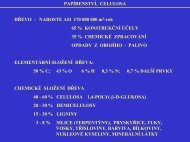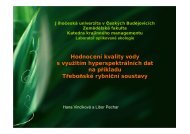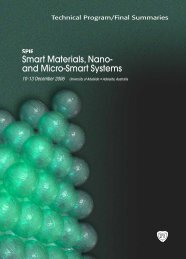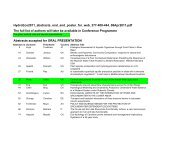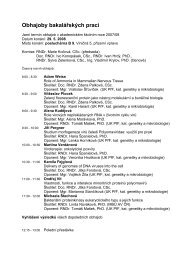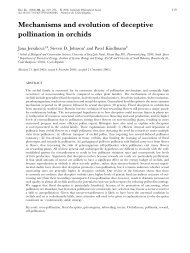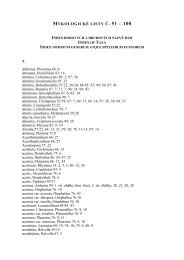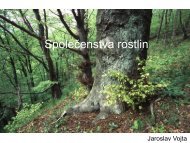Symbiotic relationship between Cerrena unicolor and the horntail ...
Symbiotic relationship between Cerrena unicolor and the horntail ...
Symbiotic relationship between Cerrena unicolor and the horntail ...
Create successful ePaper yourself
Turn your PDF publications into a flip-book with our unique Google optimized e-Paper software.
CZECH MYCOL. 59(1): 83–90, 2007<strong>Symbiotic</strong> <strong>relationship</strong> <strong>between</strong> <strong>Cerrena</strong> <strong>unicolor</strong> <strong>and</strong> <strong>the</strong><strong>horntail</strong> Tremex fuscicornis recorded in <strong>the</strong> Czech RepublicSYLVIE PAŽOUTOVÁ 1 <strong>and</strong> PETR ŠRŮTKA 21Institute of Microbiology ASCR, Vídeňská 1083, 142 20 Prague 4, Czech Republicpazouto@biomed.cas.czFaculty of Forestry <strong>and</strong> Environment, Czech University of Life Sciences, 165 21 Prague 6, Czech Republic2Pažoutová S. <strong>and</strong> Šrůtka P. (2007): <strong>Symbiotic</strong> <strong>relationship</strong> <strong>between</strong> <strong>Cerrena</strong><strong>unicolor</strong> <strong>and</strong> <strong>the</strong> <strong>horntail</strong> Tremex fuscicornis recorded in <strong>the</strong> Czech Republic. –Czech Mycol. 59(1): 83–90.From a specimen of Acer saccharinus collected in a Prague park, 38 females of Tremexfuscicornis (Hymenoptera, Siricidae) were reared <strong>and</strong> sixteen isolates of a symbiotic basidiomycetewere isolated from <strong>the</strong>ir mycangia. All isolates shared morphology <strong>and</strong> RAPD patterns. The fungus wasidentified using rDNA (regions ITS1, 5.8S, ITS2, <strong>and</strong> D1D2 part of <strong>the</strong> 28S rDNA) as <strong>Cerrena</strong> <strong>unicolor</strong>(Basidiomycota: Polyporales). The identification is discussed with respect to related <strong>horntail</strong> taxa <strong>and</strong>former identification attempts.Key words: Tremex fuscicornis, <strong>Cerrena</strong> <strong>unicolor</strong>, Tremicinae, insect–fungus symbiosisPažoutová S. a Šrůtka P. (2007): Nález symbiózy mezi houbou <strong>Cerrena</strong> <strong>unicolor</strong>a pilořitkou Tremex fuscicornis v České republice. – Czech Mycol. 59(1): 83–90.Ze vzorku napadeného dřeva odebraného z javoru Acer saccharinum rostoucího v pražském parkubylo vychováno 38 samic pilořitky Tremex fuscicornis (Hymenoptera, Siricidae). Z jejich mykangiíbylo získáno 16 kultur symbiotické houby ze skupiny Basidiomycota, které se shodovaly morfologickyi v analýze RAPD. Houba byla určena na základě sekvence rDNA (oblasti ITS1, 5.8S, ITS2 a úsek D1D2z 28S) jako <strong>Cerrena</strong> <strong>unicolor</strong> (Basidiomycota: Polyporales).INTRODUCTIONFemale wood wasps of <strong>the</strong> genus Tremex (<strong>horntail</strong>) carry symbioticbasidiomycetes in <strong>the</strong>ir mycangia (intersegmental pouches at <strong>the</strong> base of ovipositor)in <strong>the</strong> form of single cells <strong>and</strong> mycelial fragments (Francke-Grosmann 1939).During oviposition in <strong>the</strong> cambium layer, oidia are inoculated into <strong>the</strong> wood toge<strong>the</strong>rwith <strong>the</strong> egg <strong>and</strong> phytotoxic mucus.The fungus <strong>the</strong>n colonizes <strong>the</strong> wood; <strong>the</strong> larvae tunnel through <strong>the</strong> decayingwood, ingesting both wood <strong>and</strong> <strong>the</strong> hyphae of <strong>the</strong> fungus (Francke-Grosmann 1939,Eichhorn 1982). The symbiont is essential for fur<strong>the</strong>r larval development; eggs ofTremex columba (L.) originating from females raised without <strong>the</strong> symbiotic fungushatch, but larvae cannot develop beyond <strong>the</strong> first instar (Stillwell 1967).83
CZECH MYCOL. 59(1): 83–90, 2007In T. columba, a North American species, its symbiotic fungus was identifiedas <strong>Cerrena</strong> <strong>unicolor</strong> (Bull.) Murrill using <strong>the</strong> dikaryotization technique (Stillwell1964, 1965). The same fungus was identified in mycangia of Tremex longicollis(Konow) collected in Japan (Tabata <strong>and</strong> Abe 1995). In this case, basidiocarps of C.<strong>unicolor</strong> were found near <strong>the</strong> emergence hole of <strong>the</strong> <strong>horntail</strong> <strong>and</strong> mating <strong>between</strong>single basidiospore mycelia of C. <strong>unicolor</strong> <strong>and</strong> single-arthrospore mycelia from<strong>the</strong> mycangia of <strong>the</strong> <strong>horntail</strong> showed that <strong>the</strong>y were compatible.The distribution of Tremex fuscicornis (Fabricius) is Eurasian. In Europe, especiallyin nor<strong>the</strong>rn regions, Tremex fuscicornis is ra<strong>the</strong>r rare (Pisarski 1956,Eichhorn 1982, Taeger et al. 1998, Witmond 1999, Bergsten <strong>and</strong> Hedström 2004).T. fuscicornis was recently introduced to Chile probably with wooden cratesfrom China infested with <strong>horntail</strong> larvae <strong>and</strong> pupae. Its spreading led to disastrousresults (Baldini 2002) as <strong>the</strong>re has been no natural predator of <strong>the</strong> invader.In <strong>the</strong> Czech Republic, this <strong>horntail</strong> is also not often encountered, although itsoccurrence was recorded in <strong>the</strong> 1940’s <strong>and</strong> 1950’s (Gregor <strong>and</strong> Baťa 1940, Bouček<strong>and</strong> Pádr 1957). Records of rare specimens do not allow for basic bionomical studies– <strong>the</strong> only exception is <strong>the</strong> finding of Ibalia jakowlewi parasitizing T. fuscicornis(Pfeffer 1983). Recently, occasional findings were made in <strong>the</strong> course offaunistic searches using effective Malaise traps (Dr. Jan Macek, National MuseumPrague, personal communication).The first attempt at identification of a symbiont of T. fuscicornis was made byFrancke-Grosmann (1939). She isolated fungi from T. fuscicornis infested specimensof Populus sp. (poplar) <strong>and</strong> Juglans regia (walnut), collected in Germany.The “poplar fungus” was isolated from mycangia, whereas <strong>the</strong> “walnut fungus”was obtained only from galleries, as no females emerged from <strong>the</strong> wood specimen.The cultures differed in <strong>the</strong>ir mycelial morphology. An attempt to obtainbasidiocarps on inoculated sterilized wood sticks in a wet chamber succeededonly with <strong>the</strong> “walnut fungus”, which was <strong>the</strong>n identified as Polyporus imberbis(now Bjerk<strong>and</strong>era fumosa) <strong>and</strong> later mentioned as a putative T. fuscicornissymbiont in <strong>the</strong> literature. The o<strong>the</strong>r fungus produced no fructification <strong>and</strong> <strong>the</strong>reforeremained unidentified <strong>and</strong> unmentioned.Palma et al. (2005) succeeded in producing basidiocarps of <strong>the</strong> symbiotic fungusfrom <strong>the</strong> invading T. fuscicornis on sterilized pieces of poplar wood. The cultivatedfruit bodies of <strong>the</strong> symbiont were identified as those of C. <strong>unicolor</strong>.Regarding <strong>the</strong> <strong>relationship</strong> <strong>between</strong> siricid species <strong>and</strong> <strong>the</strong>ir fungal symbiontsit was shown that a specific species of Sirex or Urocerus always carried <strong>the</strong> samespecies of Amylostereum; however, one fungal species can be carried by severalwasp species (Gaut 1970; Tabata <strong>and</strong> Abe 1997, 1999). On <strong>the</strong> o<strong>the</strong>r h<strong>and</strong>,xylariaceous symbionts of Xiphydria woodwasps belong to two albeit relatedgenera <strong>and</strong> females of Xiphydria longicollis (even those emerging from <strong>the</strong> sametree) can carry ei<strong>the</strong>r of <strong>the</strong> fungi (Šrůtka et al. 2007).84
PAŽOUTOVÁ S. AND ŠRŮTKA P.: RELATIONSHIP BETWEEN CERRENA UNICOLOR AND TREMEX FUSCICORNISThe data collected so far suggest that T. fuscicornis may share <strong>the</strong> C. <strong>unicolor</strong>symbiont with T. columba <strong>and</strong> T. longicollis outside Europe. The equivocal findingsof Francke-Grosmann from Germany, however, raises questions about thishypo<strong>the</strong>sis. The aim of this study was <strong>the</strong>refore to identify <strong>the</strong> symbiont in specimensof T. fuscicornis of European origin.MATERIALS AND METHODSIsolation <strong>and</strong> cultivationAdults of T. fuscicornis have been reared (Šrůtka et al. 2007) from a part ofa trunk of Acer saccharinus collected in Prague (50°6'2.40"N 14°23'42.53"E).From <strong>the</strong> incubated wood specimen (28 × 100 cm), thirty-eight females (Fig. 2)emerged but not a single male, probably due to <strong>the</strong> differences in <strong>the</strong> duration ofmale <strong>and</strong> female larval development. The insects were killed by an injection ofethylacetate into <strong>the</strong> thorax <strong>and</strong> dissected. The content of <strong>the</strong> mycangia wasstreaked with a sterile needle onto 2 % malt extract agar (MEA) (Difco, Detroit,USA) <strong>and</strong> <strong>the</strong> resulting 16 cultures maintained on MEA slants at 4 °C.DNA analysisDNA was isolated from young cultures grown on cellophane laid on MEA agarplates using an UltraClean Microbial DNA Isolation Kit (Mo-Bio Laboratories, California)according to <strong>the</strong> manufacturer’s manual. Nuclear rDNA containing <strong>the</strong> internaltranscribed spacers (ITS1 <strong>and</strong> ITS2), 5.8S rDNA, <strong>and</strong> <strong>the</strong> D1D2 region of28S rDNA was amplified with primers ITS5 <strong>and</strong> NL4 (White et al. 1990) ina Mastercycler Gradient (Eppendorf, Germany) as follows: 1 cycle of 3 min at95 °C, 30 s at 55 °C <strong>and</strong> 1 min at 72 °C, 30 cycles of 30 s at 95 °C, 30 s at 55 °C <strong>and</strong>1 min at 72 °C <strong>and</strong> 1 cycle 30 s at 95 °C, 30 s at 55 °C <strong>and</strong> 10 min at 72 °C. The reactionmix consisted of PCR buffer (Finnzymes, Finl<strong>and</strong>), deoxynucleotide mixture0.2 mM, 2 pmol of each primer, 1 U of DynaZyme (Finnzymes, Finl<strong>and</strong>) <strong>and</strong>5–50 ng of DNA in 25 μl of total volume. Amplified fragments were purified <strong>and</strong>custom-sequenced in Macrogen (South Korea). The sequence was <strong>the</strong>n depositedin GenBank under <strong>the</strong> accession No. EF577058 <strong>and</strong> compared to NCBI databasesequences using BLAST (Altschul et al. 1990). RAPD patterns were obtained usingprimer 8F (5´-GCTCTGAGATTGTTCCGGCT) (Pažoutová <strong>and</strong> Frederickson 2005).RAPD patterns were obtained using primers 5R (TTTGTCCGGCTCAGAAAC),8F (GCTCTGAGATTGTTCCGGCT), OPA-09 (GGGTAACGCC) <strong>and</strong> OPA-20(GTTGCGATCC), both from Operon Technologies, CA. The reaction mixture containedin 20 μl: DynaZyme reaction buffer, 0.2 mM deoxynucleotides, 2 pmol of <strong>the</strong>primer, 1 U of DynaZyme, MgCl 2in a total concentration of 1.75 mM, <strong>and</strong> 5–50 ngof DNA. The cycling was as follows: 33 cycles of 93 °C for 20 s, 38 °C for 1 min85
CZECH MYCOL. 59(1): 83–90, 2007Fig. 1. Silver maple tree with emergence holes. Bar – 10 cm.Fig. 2. Female of Tremex fuscicornis on silver maple. Bar – 1 cm.Fig. 3. Dissected female of Tremex fuscicornis: a – mycangium, b – mucus reservoir, c – ovipositor.Bar – 1 cm.Fig. 4. Oidium of <strong>Cerrena</strong> <strong>unicolor</strong> with a clamp. Bar – 10 μm.72 °C for 20 s with an initial denaturation step at 93 °C for 3 min <strong>and</strong> <strong>the</strong> last elongationstep at 72 °C for 6 min.MicroscopySamples were mounted in 1 % cotton blue in lactophenol <strong>and</strong> observed usinga JENAVAL microscope (Zeiss, Germany) <strong>and</strong> a Nikon SMZ-1B Stereo Zoom Microscope.Photographs were taken using a Camedia C-5060 WZ camera (Olympus)<strong>and</strong> image-processing software QuickPHOTO Camera 2.2.RESULTS AND DISCUSSIONThe present study was initiated after discovering a heavily infested trunk ofa silver maple tree (Acer saccharinum) in a busy urban park in Victory Place,86
PAŽOUTOVÁ S. AND ŠRŮTKA P.: RELATIONSHIP BETWEEN CERRENA UNICOLOR AND TREMEX FUSCICORNISFig. 5. RAPD patterns of 16 isolates obtained with four primers.Fig. 6. Phylogram of <strong>Cerrena</strong> <strong>unicolor</strong> from Tremex fuscicornis <strong>and</strong> related fungi. The alignment consistedof 647 sites (54 parsimony-informative <strong>and</strong> 45 singletons). The phylogram was obtained usingKimura 2-parameter distance model (with pairwise deletion option <strong>and</strong> 1000x bootstrap) <strong>and</strong> <strong>the</strong> neighbour-joiningtree constructing method as implemented in MEGA 3.1 software (Kumar et al. 2004). Thebootstrap support values are given on <strong>the</strong> branches.Prague (50°6'2.40"N, 14°23'42.53"E). The unusually high occurrence of <strong>the</strong> ra<strong>the</strong>rrare <strong>horntail</strong> in a city park might be explained by <strong>the</strong> absence of its natural predators– parasitic wasps, as <strong>the</strong> park is isolated from o<strong>the</strong>r green areas by surroundinghigh houses. Conspicuous <strong>and</strong> numerous emergence holes (3–7 mm in diameter)about 0.5-1 m from <strong>the</strong> trunk base were observed (Fig. 1, Fig. 2).87
CZECH MYCOL. 59(1): 83–90, 2007In <strong>the</strong> dissected female, paired mycangia were found directly below <strong>the</strong>subgenital plate (Fig. 3), immediately at <strong>the</strong> ovipositor entry. A reservoir containedclear colorless mucus. Inside <strong>the</strong> mycangia, mucus-suspended small hyphalfragments (oidia) bearing clamps were found (Fig. 4).Pure cultures on MEA were all of identical appearance. The colony consistedof rich white cottony aerial mycelium. The reverse of <strong>the</strong> colonies was colourless;no pigments were produced even after 1 month of cultivation. During maximumgrowth <strong>the</strong> growth rate was 10-13 mm per day.RAPD patterns of all isolates were identical with all four primers used (Fig. 5),confirming thus that <strong>the</strong> isolates belonged to <strong>the</strong> same fungal species. The identicalpatterns suggested that <strong>the</strong> isolates may even belong to a clonal population.As <strong>the</strong> morphology was uninformative, rDNA sequence comparison was usedfor <strong>the</strong> identification of a Tremex symbiont. The 28S rDNA region (607 bp) was98.3 % identical to C. consors AY515343 <strong>and</strong> 97.6 % identical to that of <strong>Cerrena</strong>consors AY515338 (Kim et al. 2005).A database search of sequences of ITS1-5.8S-ITS2 region found <strong>the</strong> highestsimilarity to sequence of <strong>Cerrena</strong> <strong>unicolor</strong> (DQ056858) (Janusz <strong>and</strong> Rogalski, unpublished)with only a single base difference. The sequence originated from anisolate deposited at Botanical Institute II, University of Regensburg (Germany) asNo. T143, <strong>and</strong> in Fungal Culture Collection of <strong>the</strong> Department of BiochemistryUMCS in Lublin (Pol<strong>and</strong>) as No. 139 (G. Janusz, personal communication). Twounidentified white rot fungi (AY968078, AY840564) (Zhang et al. 2006) were alsoclosely related. The phylogram (Fig. 6) has shown that <strong>the</strong>se four fungi clusteringtoge<strong>the</strong>r ei<strong>the</strong>r all represent C. <strong>unicolor</strong>, or a complex of sister species.In <strong>the</strong> distance tree generated by NCBI Blast from database sequences, <strong>the</strong> C.<strong>unicolor</strong> clade was fur<strong>the</strong>r related to a clade containing several sequences of unidentifiedAphyllophorales from Theobroma (here represented by EF060457) <strong>and</strong> of twoendophytes from Taxus mairei (represented by AY433810, Wang <strong>and</strong> Wang, unpublished).A phytopathogenic fungus Pseudolagarobasidium acaciicola from wattle(Wood <strong>and</strong> Ginns 2006) was in <strong>the</strong> NCBI Blast distance tree on ancestral position to<strong>the</strong> above clades <strong>and</strong> was added as an outgroup. Database sequences of Bjerk<strong>and</strong>eraadusta (DQ060097, AY319191) <strong>and</strong> Bjerk<strong>and</strong>era fumosa (AJ006673) were in <strong>the</strong> regionsof ITS1 <strong>and</strong> ITS2 hardly alignable with that of <strong>the</strong> symbiotic fungus.From <strong>the</strong> two fungi that Francke-Grosmann (1939) isolated, <strong>the</strong> colony morphologyof <strong>the</strong> “poplar fungus” resembled that of our isolates of C. <strong>unicolor</strong>, especiallyin <strong>the</strong> relatively quick growth, lack of pigments in agar <strong>and</strong> rich white aerialmycelium formation. Francke-Grosmann noted a morel-like smell of <strong>the</strong> cultures,whereas we did not find any.C. <strong>unicolor</strong> is confirmed by <strong>the</strong> above results <strong>and</strong> <strong>the</strong> observations of Palma etal. (2005) as a common symbiont of T. fuscicornis across its distribution area,shared also by T. colomba, <strong>and</strong> T. longicollis.88
PAŽOUTOVÁ S. AND ŠRŮTKA P.: RELATIONSHIP BETWEEN CERRENA UNICOLOR AND TREMEX FUSCICORNISACKNOWLEDGEMENTSThis work was supported by <strong>the</strong> Czech Institutional Research Concept No.AV0Z5020903 <strong>and</strong> Czech Sciences Foundation, grant No. 206/07/0283.REFERENCESALTSCHUL S., GISH W., MILLER W., MYERS E. <strong>and</strong> LIPMAN D. (1990): Basic local alignment search tool. –J. Mol. Biol. 215: 403–410.BALDINI A. (2002): Tremex fuscicornis: Un factor de daño para el recurso forestal y agrícola. –Agronomia y Forestal UC 16: 11–13.BERGSTEN J. <strong>and</strong> HEDSTRÖM P. (2004): Korthornad vedstekel, Tremex fuscicornis, funnen i Lulelappmark (Hymenoptera: Siricidae). – Natur i Norr, Umeå 23: 51–53.BOUČEK Z. <strong>and</strong> PÁDR Z. (1957): Širopasí – Symphyta. – In: Kratochvíl J. (ed.), Klíč zvířeny ČSR, díl II–Třásnokřídlí, blanokřídlí, řásnokřídlí, brouci, p. 46–87, Praha.EICHHORN O. (1982): Siricidae – Holzwespen. – In: Schwenke W. (ed.), Die Forstchädlinge Europas, IV.B<strong>and</strong> – Hautflügler und Zweiflügler, p. 196–231, Hamburg, Berlin.FRANCKE-GROSMANN H. (1939): Über das Zusammenleben von Holzwespen (Siricinae) mit Pilzen. –Zschr. Angew. Entomol. 25: 647–680.GAUT I. P. C. (1970): Studies of siricids <strong>and</strong> <strong>the</strong>ir fungal symbionts. – University of Adelaide, Adelaide,Australia.GREGOR F. <strong>and</strong> BAŤA L. (1940): Prodromus našeho blanokřídlého hmyzu, část IV., Symphyta. – Sborníkentomologického oddělení Národního musea 18: 203–240.KIM K. M., YOON Y. G. <strong>and</strong> JUNG H. S. (2005): Evaluation of <strong>the</strong> monophyly of Fomitopsis using parsimonymethod <strong>and</strong> MCMC computation. – Mycologia 97: 812–822.KUMAR S., TAMURA K. <strong>and</strong> NEI M. (2004): MEGA3: Integrated software for molecular evolutionary geneticsanalysis <strong>and</strong> sequence alignment. – Brief. Bioinform. 5: 150–163.PALMA M. A., VALENZUELA E., PARRA P., GUTIERREZ M. <strong>and</strong> SILVA L. T. (2005): <strong>Cerrena</strong> <strong>unicolor</strong> (Bull.)Murr. (Basidiomycota) aislado de micangio de Tremex fuscicornis Fabr. (Hymenoptera, Siricidae)asociado a decaimiento y pudrición del álamo (Populus sp.) en Chile. – Bol. Micol. 202: 57–61.PAŽOUTOVÁ S. <strong>and</strong> FREDERICKSON D. E. (2005): Genetic diversity of Claviceps africana on Sorghum<strong>and</strong> Hyparrhenia. – Plant Pathol. 54: 749–763.PFEFFER A. (1983): Faunistic records from Czechoslovakia. Hymenoptera, Ibaliidae. – Acta Entomol.Bohemosl. 80: 237.PISARSKI B. (1956): Klucze do oznaczania owadów Polski, Część XXIV – Blonkówki (Hymenoptera),Zeszyt 2 – Trzpiennikowate (Siricidae), Zeszyt 3 – Oryssidae. – PWN, Warszawa, Pol<strong>and</strong>.ŠRŮTKA P., PAŽOUTOVÁ S. <strong>and</strong> KOLAŘÍK M. (2007): Daldinia decipiens <strong>and</strong> Entonaema cinnabarina asfungal symbionts of Xiphydria wood wasps. – Mycol. Res. 111 (in press).STILLWELL M. A. (1964): The fungus associated with woodwasps occurring in beech in New Brunswick.– Can. J. Bot. 42: 495–497.STILLWELL M. A. (1965): Hypopleural organs of <strong>the</strong> woodwasp larva Tremex columba (L.) containing<strong>the</strong> fungus Daedalea <strong>unicolor</strong> Bull. ex Fries. – Can. Entomol. 97: 783–784.STILLWELL M. A. (1967): The pigeon tremex, Tremex columba (L.) (Hymenoptera, Siricidae) in NewBrunswick. – Can. Entomol. 99: 685–689.TABATA M. <strong>and</strong> ABE Y. (1995): <strong>Cerrena</strong> <strong>unicolor</strong> isolated from <strong>the</strong> mycangia of a <strong>horntail</strong>, Tremexlongicollis, in Kochi Prefecture, Japan. – Mycoscience 36: 447–450.89




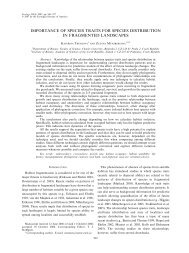
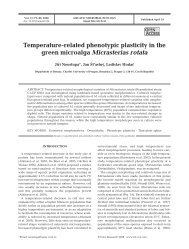
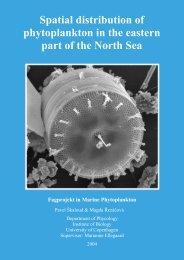
![[Cr(urea)6]Cl3](https://img.yumpu.com/47220263/1/184x260/crurea6cl3.jpg?quality=85)
